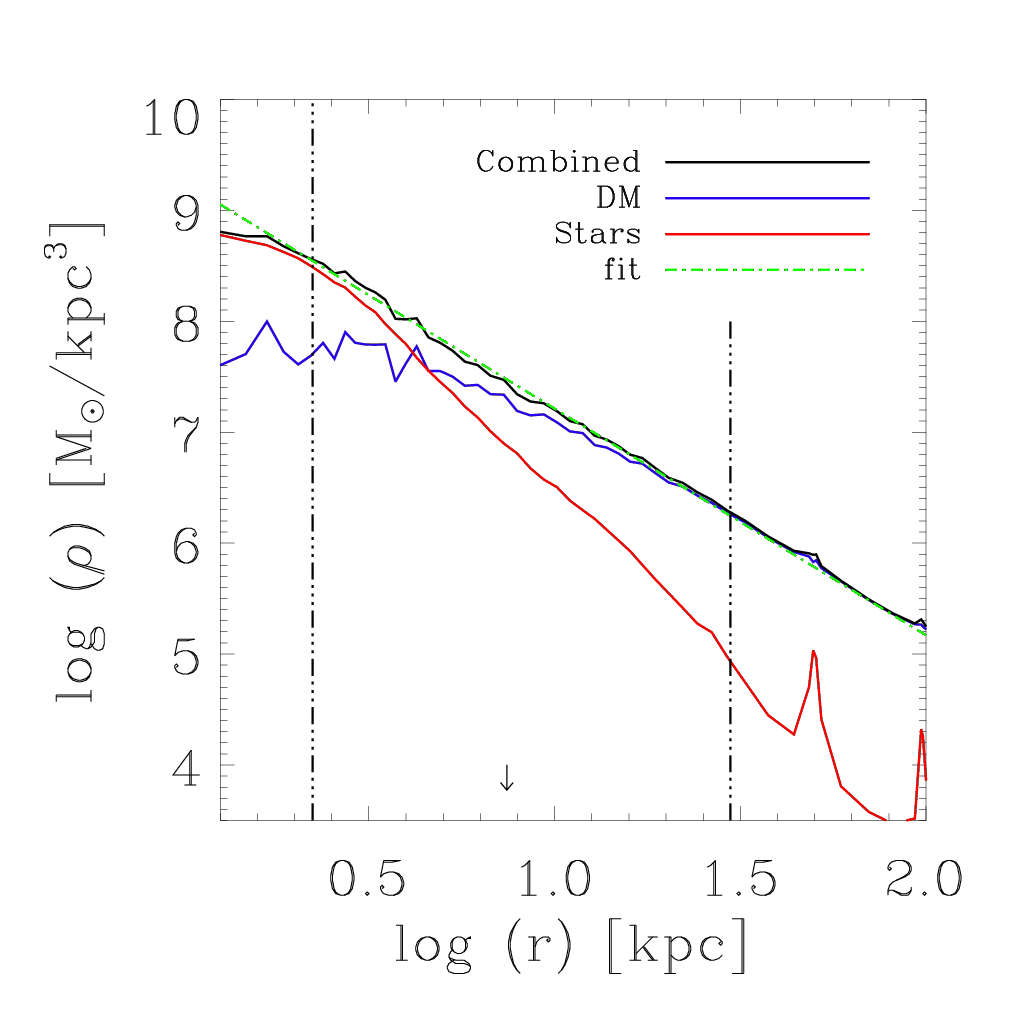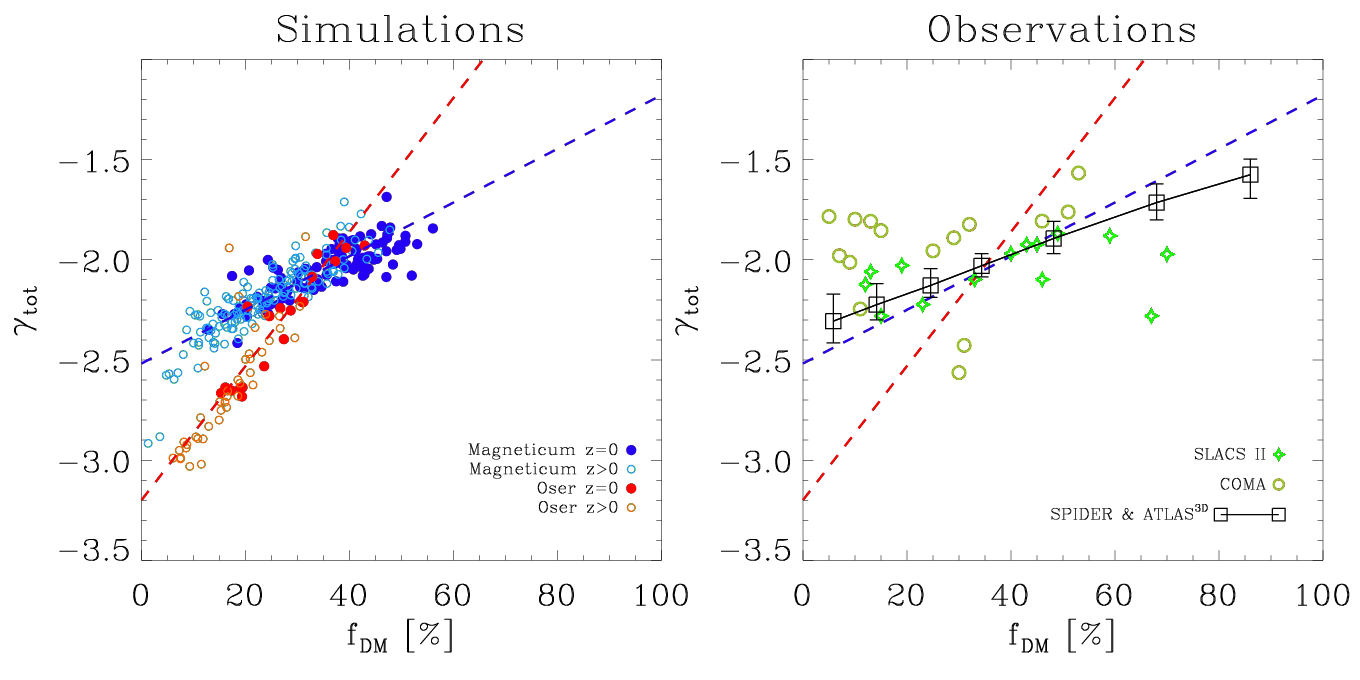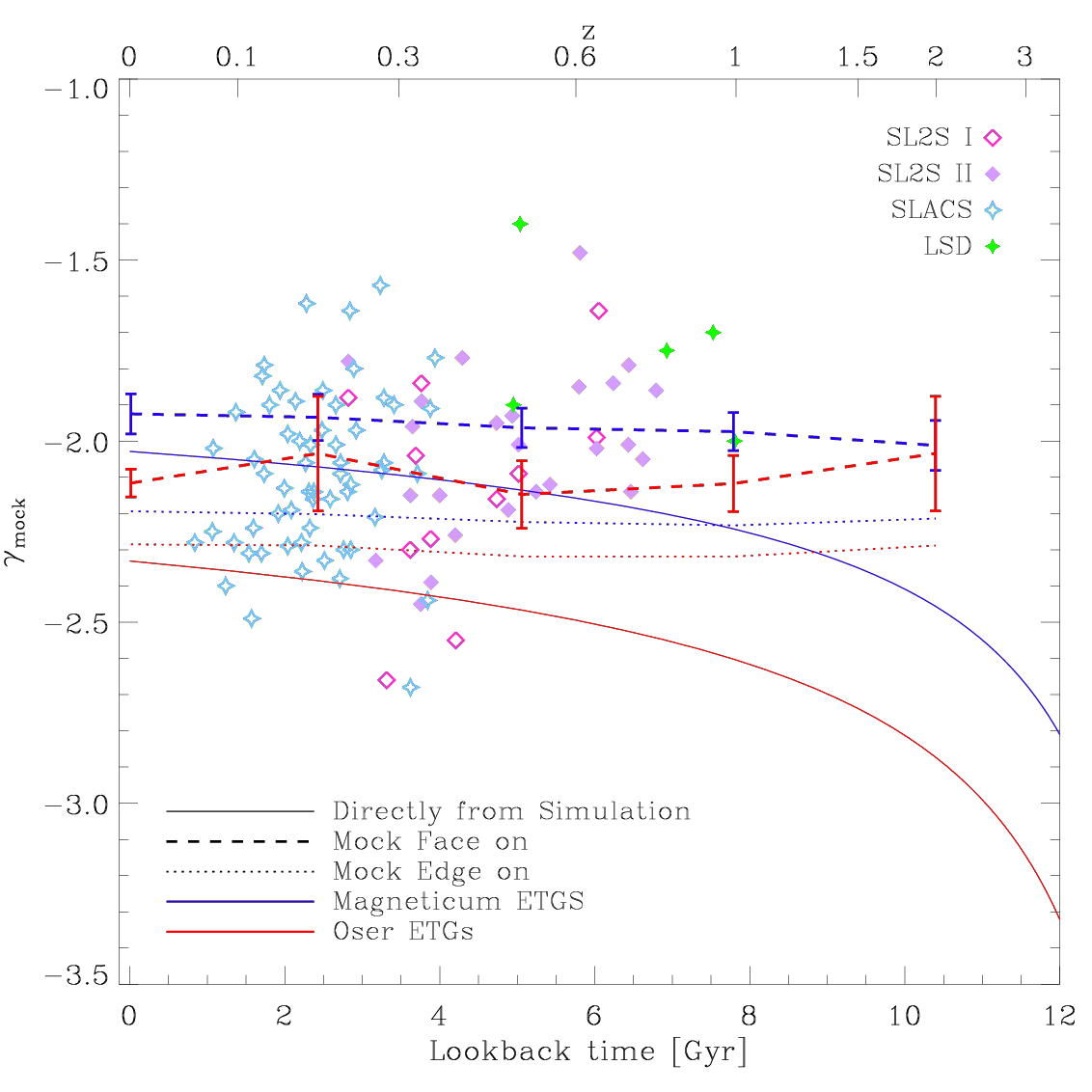|
To understand the interplay between the baryonic and the dark matter component of galaxies, especially in quiescent (elliptical and S0) galaxies, is one of the main topics of my research.
Understanding the mechanisms that are important for the growth of such galaxies, the quenching mechanisms that lead to the formation of quiescent massive systems, as well as the build-up of global scaling relations of all kind of galaxies, are some of the most enthralling questions in extragalactic astronomy.
Here, I present short descriptions of the interesting results of my work:
The
Dark Halo–Spheroid Conspiracy,
the
Co-Evolution of Total Density Slopes and Central Dark Matter Fractions,
and
The Evolution of the Total Density Slope with Redshift in Simulations and Observations.
· · · ·
Dark Halo–Spheroid Conspiracy
 Dynamical modelling and strong lensing data suggest that the total density profiles of early-type galaxies are close to isothermal, i.e.,
ρtot ∝ r γ
with
γ ≈ −2.
To understand the origin of this universal slope I have studied quiescent, early-type galaxies (ETGs) from several simulation set-ups so far, including ETGs formed in isolated binary mergers, ETGs from cosmological zoom-simulations with different physics setups, and ETGs selected from fully hydrodynamical cosmological simulation volumes.
Independent of the studied simulation set, I always find that the total (stellar plus dark matter) density profiles can be described by a power law with an index of
γ ≈ −2
with a tendency towards steeper slopes for more compact, lower-mass ETGs.
Generally, ETGs with steeper slopes have higher fraction of stars formed in-situ. This trend is weakened if AGN feedback is included, however.
The precise steepness of the slope is determined by the merger events that an ETG suffered: Each gas-poor merger event evolves the slope towards
γ ∼ −2,
but once this slope is reached further dry merger events do not change it anymore. On the other hand, merger events that involve gas have the opposite effect,
steepening the slope again. Nevertheless, gas-rich merger events are less likely the lower the redshift and the denser the environment, thus explaining the observed mass trends.
Dynamical modelling and strong lensing data suggest that the total density profiles of early-type galaxies are close to isothermal, i.e.,
ρtot ∝ r γ
with
γ ≈ −2.
To understand the origin of this universal slope I have studied quiescent, early-type galaxies (ETGs) from several simulation set-ups so far, including ETGs formed in isolated binary mergers, ETGs from cosmological zoom-simulations with different physics setups, and ETGs selected from fully hydrodynamical cosmological simulation volumes.
Independent of the studied simulation set, I always find that the total (stellar plus dark matter) density profiles can be described by a power law with an index of
γ ≈ −2
with a tendency towards steeper slopes for more compact, lower-mass ETGs.
Generally, ETGs with steeper slopes have higher fraction of stars formed in-situ. This trend is weakened if AGN feedback is included, however.
The precise steepness of the slope is determined by the merger events that an ETG suffered: Each gas-poor merger event evolves the slope towards
γ ∼ −2,
but once this slope is reached further dry merger events do not change it anymore. On the other hand, merger events that involve gas have the opposite effect,
steepening the slope again. Nevertheless, gas-rich merger events are less likely the lower the redshift and the denser the environment, thus explaining the observed mass trends.
All studied ETGs have flat intrinsic combined stellar and dark matter velocity dispersion profiles.
Interestingly, there is no correlation between the slope of the velocity dispersion profiles and the slopes of the total density profiles.
For more details see Remus et al. (2013), Remus et al. (2017), and Bellstedt et al. (2018).
· · · ·
Co-Evolution of Total Density Slopes and Central Dark Matter Fractions
 Using cosmological hydrodynamical simulations with different feedback implementations (Magneticum includes full AGN treatment, Oser does not include AGN feedback), I find evidence for a co-evolution of the slope of the total (dark and stellar) mass density profiles,
γtot,
and the dark matter fractions within the half-mass radius,
fDM,
in ETGs. The relation between both quantities can be described as
γtot = A fDM + B,
and holds for all systems at all redshifts, with varying A and B for different feedback models.
This correlation is set by the decreasing importance of dissipative processes towards lower redshifts and for more massive systems, and .
Early-type galaxies are smaller, more concentrated, have lower dark matter fractions and steeper total density slopes at high redshifts and at lower masses for a given redshift.
The values for
A
and
B
change distinctively with the assumed feedback model, and thus this relation can be used as a test for feedback models.
A similar correlation exists between
γtot
and the stellar mass surface density
Σ∗.
The model with weak stellar feedback and, in particular, feedback from black holes is in better agreement with observations.
All simulations, independent of the assumed feedback model, predict steeper total density slopes and lower dark matter fractions at higher redshifts.
While the latter is in agreement with the observed trends, the former is in conflict with currently available lensing observations, which indicate constant or decreasing density slopes.
This discrepancy cannot be overcome by any of the feedback models included in this study.
For more details see Remus et al. (2017).
Using cosmological hydrodynamical simulations with different feedback implementations (Magneticum includes full AGN treatment, Oser does not include AGN feedback), I find evidence for a co-evolution of the slope of the total (dark and stellar) mass density profiles,
γtot,
and the dark matter fractions within the half-mass radius,
fDM,
in ETGs. The relation between both quantities can be described as
γtot = A fDM + B,
and holds for all systems at all redshifts, with varying A and B for different feedback models.
This correlation is set by the decreasing importance of dissipative processes towards lower redshifts and for more massive systems, and .
Early-type galaxies are smaller, more concentrated, have lower dark matter fractions and steeper total density slopes at high redshifts and at lower masses for a given redshift.
The values for
A
and
B
change distinctively with the assumed feedback model, and thus this relation can be used as a test for feedback models.
A similar correlation exists between
γtot
and the stellar mass surface density
Σ∗.
The model with weak stellar feedback and, in particular, feedback from black holes is in better agreement with observations.
All simulations, independent of the assumed feedback model, predict steeper total density slopes and lower dark matter fractions at higher redshifts.
While the latter is in agreement with the observed trends, the former is in conflict with currently available lensing observations, which indicate constant or decreasing density slopes.
This discrepancy cannot be overcome by any of the feedback models included in this study.
For more details see Remus et al. (2017).
· · · ·
The Evolution of the Total Density Slope with Redshift in Simulations and Observations
 Coming soon ...
Coming soon ...
| 


